M.A. Yousuf (Editor in chief): This the season when Muslims across the globe await with fervent anticipation the sighting of the crescent moon, heralding the commencement of this sacred month. Moonsighting holds paramount significance in establishing Islamic festivities, and Ramadan stands as no exception. It serves as the pivotal marker for determining the timing
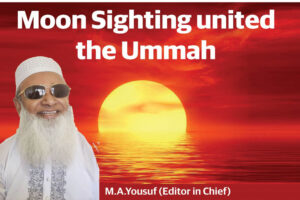
M.A. Yousuf (Editor in chief): This the season when Muslims across the globe await with fervent anticipation the sighting of the crescent moon, heralding the commencement of this sacred month. Moonsighting holds paramount significance in establishing Islamic festivities, and Ramadan stands as no exception. It serves as the pivotal marker for determining the timing of significant religious occasions, including Ramadan, the blessed month of fasting, and Eid al-Fitr, the joyous celebration marking its conclusion. Similarly, it holds sway over Hajj, the pilgrimage to Mecca, which commences during the month of Dhul-Hijjah
Moon sighting stands as a cornerstone of Islamic tradition, serving as the venerable method to mark pivotal dates within the faith. Across nations, astronomers and esteemed religious scholars engage in the sacred task of moonsighting. In certain locales, the ancient practice persists with the unaided eye, while in others, modern instruments such as telescopes or other sophisticated technologies are employed to discern the celestial crescent.
Most scholars concur that sighting the new moon of Ramadan on its inaugural night constitutes a communal obligation, wherein failure to do so incurs sin upon the collective. This stance aligns with the Hanafi school of thought as well.
Certain jurists hold the opinion that moon sighting is a recommended practice. It’s advisable to observe the new moon as a precautionary measure regarding fasting and to mitigate potential disputes. A narration attributed to Aishah (may Allah be pleased with her) recounts that the Prophet (peace and blessings of Allah be upon him) would meticulously track the days of Shaban, then commence fasting upon sighting the crescent of Ramadan. This narration, authenticated by Ad-Daraqutni, underscores the significance of moon sighting in Islamic tradition.
In Majma Al-Anhar (1/283), it is stated: “It is a communal obligation for the people to search for the new moon on the evening of the twenty-ninth of Shaban or Ramadan, as well as Dhul Qi`dah. Moreover, it is incumbent upon the ruler to command the populace to fulfil this duty.
Link : https://www.masjidqubaa.org.au/mq_downloads/Moon%20Sighting-Sheikh_Omar_El_Banna.pdf
NARRATOR AbuHurayrah
SAHIH MUSLIM
HADITH_No 2378
Allah’s Messenger (peace_be_upon_him) said: Whenever you sight the new moon (of the month of Ramadan) observe fast, and when you sight it (the new moon of Shawwal) break it, and if the sky is cloudy for you, then observe fast for thirty days.
NARRATOR AbuHurayrah
SAHIH MUSLIM
HADITH_No 2379
Allah’s Messenger (peace_be_upon_him) said: Observe fast on sighting it (the new moon) and break (fast) on sighting it (the new moon), but if the sky is cloudy for you, then complete the number (of thirty).

NARRATOR AbuUmayr ibn Anas
ABU DAWUD
HADITH_No 1153
AbuUmayr reported on the authority of some of his paternal uncles who were Companions of the Prophet (peace_be_upon_him): Some men came riding to the Prophet (peace_be_upon_him) and testified that they had sighted the new moon the previous day. He (the Holy Prophet), therefore, commanded the people to break the fast and to go out to their place of prayer in the morning.
NARRATOR Aisha, Ummul Mu’minin
ABU DAWUD
HADITH_No 2318
The Apostle of Allah (peace_be_upon_him) used to count the days in Sha’ban in a manner he did not count any other month; then he fasted when he sighted the new moon of Ramadan; but if the weather was cloudy he counted thirty days and then fasted.
NARRATOR Abdullah ibn Abbas
MISHKAT AL-MASABIH
HADITH_No 1230r
The Prophet (peace_be_upon_him) said: Do not anticipate Ramadan. Start the fast with observing the new moon and terminate it with observing it. If the sky is overcast let the month run to thirty days.
Moon sighting serves as an opportunity for communal bonding as Muslims embark on significant religious rites collectively. Prophet Muhammad himself advocated the pursuit of the crescent sighting, advising: “Do not commence fasting (for Ramadan) until the month arrives, either by sighting the moon or completing the thirty days; then fast until the moon is sighted or the thirty days are completed.
The Prophet Muhammad proclaimed, “When the month of Ramadan begins, the gates of heaven are flung wide open, while the gates of Hell are firmly sealed shut, and the malevolent forces are bound in chains.” This narration is recorded by Abu Huraira in Al-Bukhari (Vol. 3: No. 123).
The matter of moon sighting has escalated into what can be termed as “moon fighting.” In this scenario, factions on either side of the debate remain polarized, each asserting its own interpretation of what constitutes the ‘new’ moon. Intriguingly, both camps draw support for their positions from the same Hadith: “Do not fast unless you sight the crescent, and do not break your fast until you sight the (following) crescent.” (Al-Bukhari, Vol. 3:130).
The Hadith narrated by Muslim, Abu Dawud, Tirmidhi, and Nasa’i presents an argument against the obligatory nature of a moon sighting extending to distant regions. This narration recounts the encounter of Kurayb, who journeyed to Syria and witnessed the commencement of Ramadan there on a Friday. Upon his return to Medina, he informed Ibn Abbas that he had sighted the crescent moon on Friday night and that the people in Syria, including the governor Muawiyah, had commenced fasting on Friday. Ibn Abbas responded that they in Medina had sighted the crescent moon on Saturday and that they would continue fasting until they sighted it again or completed thirty days. Kurayb queried, “Is it not sufficient for you to rely on the sighting of Muawiyah?” Ibn Abbas replied, “No, for this is how the Messenger of Allah instructed us
Furthermore, it’s essential to recognize that just as Muslims worldwide do not pray simultaneously, but rather each locality observes prayer times based on the movement of the sun in their region, so too the commencement and conclusion of fasting may vary accordingly.
The contention that physical sighting and astronomical calculations hold equal validity is often overstated. Relying solely on astronomical calculations to determine the onset and conclusion of lunar months is a contentious stance, deemed by many as highly controversial if not entirely invalid. Conversely, the consensus leans towards the acceptance of physical sighting, even among proponents of astronomical calculations.
In Fathul Bari, Ibn Hajar Al Asqalany notes, “Some individuals held the view that relying on those who adhere to astronomical calculations is permissible. Among them are the Rawafid (Shi’a), and it has been reported that certain Sunni scholars concurred with them. However, Al Baji affirmed that the established scholarly consensus serves as a compelling refutation of this stance. Ibn Bazizah further asserted that this opinion is invalid.
In his commentary, Ibn Abideen remarked, “(Regarding the statement: ‘There is no significance to the statements of the astronomical calculators’) it implies their lack of relevance in determining the obligation of fasting. Moreover, in the book Al-Mi’raj, it is explicitly stated that there exists a scholarly consensus rejecting the validity of their assertions. Furthermore, the practitioner of astronomical calculations is not permitted to fast based solely on his own calculations.
The High Council of Scholars of Saudi Arabia, in Decision No. 34 dated 14/2/1395, stated, “By Scholarly Consensus, there exists no legal connection between the mere birth of the new moon and the commencement or conclusion of the lunar month, unless substantiated by physical sighting. This pertains specifically to the timing of religious observances. Any contemporary scholar holding a divergent view is contradicted by the consensus of his predecessors and thus his opinion is dismissed
The International Islamic Jurisprudence Committee, convened during the 3rd convention in Amman, Jordan (8th‐13th of Safar 1407 A.H), (11th ‐16th October 1986), in Decision No.18 (3/6) regarding the standardization of lunar month beginnings, asserted:
“Secondly: It is obligatory to rely on physical sighting. Astronomical calculations and observatories may be utilized to support physical sighting.
Numerous official Islamic organizations have issued Fatawa rejecting reliance on Astronomical Calculations.
The visibility of the lunar crescent, determined by the Moon’s age since the New Moon, holds profound significance for Muslims. While the precise date and time of each New Moon can be accurately computed, the initial sighting of the crescent afterward is subject to various factors and remains unpredictable. During the first two days post-New Moon, the crescent appears exceptionally low in the western sky after sunset, often obscured by bright twilight, and sets shortly thereafter. Observing the lunar crescent within one day of New Moon typically proves challenging, given its thinness and low surface brightness amidst twilight. Generally, the crescent becomes discernible to experienced observers in favorable sky conditions approximately one day after New Moon. However, the actual visibility time varies significantly from month to month. Notably, while exceptional sightings with telescopes have occurred as early as 12.1 hours after New Moon, and with the naked eye at 15.5 hours, such occurrences are rare exceptions rather than the norm. For Islamic calendar purposes, the sighting must be made solely with the unaided eye.
If certain Islamic groups indeed rely on Astronomical Calculations, why not issue a formal statement outlining the specific method they employ? Why maintain the annual suspense preceding Ramadan and Eid? Instead of revealing the dates each year, why not provide a forecast for Ramadan and Eid over the next decade? Astronomically, such information is accessible for centuries to come.
Some Islamic groups claim to adhere to Global Sighting, asserting its validity in Islamic jurisprudence. However, this opinion lacks historical precedent in Islam. Firstly, Global sighting does not equate to following Saudi Arabia; rather, it entails adhering to the first reported physical sighting from any location worldwide. Secondly, Saudi Arabia, in its present territorial configuration, did not exist as a state during the time of the Prophet, rendering it illogical for any Islamic ruling to hinge upon it. It’s noteworthy that scholars within Saudi Arabia themselves acknowledge the fallacy of this opinion, yet some individuals persist in its adherence. Furthermore, fixing a specific country or city, such as Mecca, for crescent sighting contradicts Islamic principles, as it would imply that fasting becomes obligatory only for those sighting the crescent in that designated location, disregarding sightings elsewhere.
Proponents of this approach are primarily focused not on the specific methodology employed by certain groups to determine the commencement and conclusion of the lunar month. Instead, they argue that unity within the community should take precedence, advocating for adherence to the majority opinion to avoid division. As some groups and their followers constitute the majority, they suggest simply following their determination.
In Islam, the value attributed to the majority of the public is limited, as Allah (SWT) states, “If you obey the majority of people on earth, they will surely lead you astray” (Surah Al‐Anaam verse 116). However, Islam accords significance to the majority opinion among scholars. When we learn that the majority of scholars are in agreement on a matter, it carries considerable weight, unlike the majority opinion of the general populace.
In our community, there are individuals who do not adhere consistently to a specific method for determining the commencement and conclusion of the lunar month. They exhibit a haphazard approach, mixing and matching opinions according to their whims. Some may opt for Global sighting to initiate the month but resort to regional sighting to conclude it, while others may rely on astronomical calculations in one year and switch methods the next. Perhaps most amusing are those who follow the astronomical calendar throughout the year but suddenly engage in moon sighting on the 29th of Shaaban according to their calendar in anticipation of Ramadan.
Regrettably, within our community, there persists a recurring issue that we encounter annually. When the crescent moon eludes sight in Australia on a particular day, some individuals hastily turn their attention to the following day, making uninformed remarks such as, “Look! Look! The crescent appears to be 2 days old! It’s unmistakably visible and positioned high in the horizon!” Others may argue, “No, it’s actually 3 days old,” sparking further debate and confusion.
Link : https://www.masjidqubaa.org.au/mq_downloads/MOON%20SIGHTING-Dr_Shabbir_Ahmed.pdf
The moon completes its orbit around the Earth in approximately 29 days, 12 hours, 44 minutes, and 2.9 seconds, a period known as the Synodic month.
As the Moon revolves, there comes a moment when the Sun, Moon, and Earth align perfectly in a straight line, known as the New Moon phase. During this phase, the portion of the moon facing Earth is entirely engulfed in shadow, rendering it invisible. Following the New Moon, the moon begins its transition into a crescent shape, although it remains imperceptible to observers at this stage.
The Moon will not be visible until:
- The age of the moon is 18 hours old (the age since the New Moon).
- The Moon is at 10-degrees elongation from the Earth
- The Moon remains in the horizon for at least 45 minutes after sunset
Link : https://www.moonsighting.com/mcw.html
According to the majority of Fuqahaa, Imaam Maaliki الحمدالله Imaam Ahmad الحمدالله and Imaam Abu Hanifa الحمدالله ,
Ikhtilaaf-e-Mataalie (different zones) are not considered for fasting. The sighting of one place could be considered for
another place on condition the sighting was possible and reliable and sighting of another place will not lead to the
month being 28 days or 31 days.
When the Muslims of England started following the sighting of Saudi Arabia, many open and glaring discrepancies of
the Saudi sighting have come to the fore. For example, the Saudi calendar is based on GMT (GreenwichMeridian
Time) and the announcement for Ramadhaan is made almost 1.5 (one and a half) days before the visibility of the
crescent. There is no way that the month of Ramadhaan could commence at that time.
We are faced with a situation of following an incorrect announcement of commencing Ramadhaan and the Hadith of
Rasululla وسلم عليه االله صلى . The respect of the Haramayn is because of Shari’ah, Allah and His Rasulullaوسلم عليه االله صلى . Not
because of the incorrect announcement of some organisation in Saudi Arabia. It will be against respect of the
Haramayn to ignore the Hadith of Rasulullah وسلم عليه االله صلى and commence Ramadhaan based on Saudi’s incorrect calculation.
Individuals who adhere to the calendar method were surveyed to understand why they deviate from the Islamic method (Sharia) of moon sighting. The majority cited their alignment with the practices of the Big Mosque, which follows the lead of Saudi Arabia. However, it’s crucial to reflect: did Allah SWT and our beloved Prophet SAS instruct us to follow Saudi Arabia, or did they guide us through the Holy Quran & Hadith? Consider this: who does Saudi Arabia follow? It’s widely known that they align themselves with the USA, raising questions about their role in this matter. Is this reminiscent of the old British strategy of “divide and rule”?
Additionally, why selectively follow Saudi Arabia for Eid prayers while disregarding the same for the five daily Salah prayers? The time difference between Saudi Arabia and Sydney, Australia, is significant—7 hours ahead, to be exact. Consequently, when Eid Salah is performed in Australia, Saudi Arabia is often fast asleep, indicating that those in Australia are praying before their Saudi counterparts. This discrepancy calls into question the notion of unequivocally following Saudi practices.
Moreover, some community elders have mentioned that, as they invite numerous Ministers and Premiers on Eid day, they must determine the date in advance. If they were to invite any Minister or MP and state that the invitation depends on moon sighting, it’s likely that no one would attend due to uncertainty. They prioritize accommodating the schedules of Ministers and Premiers, necessitating the fixation of Eid dates years in advance. It’s a simple equation: every MP and Minister is busy, so accommodating their schedules is essential for invitations. Consequently, Eid dates are predetermined for the sake of convenience.
Ultimately, the unity of the Ummah should be under the umbrella of Deen, guided by the Holy Quran and Hadith. Any alternative attempts at unity may actually serve to undermine Islam. Those who pursue such paths may face severe consequences in the Hereafter. May Allah SWT grant us a profound understanding of Deen.

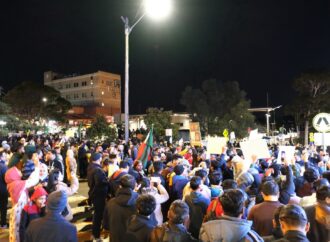



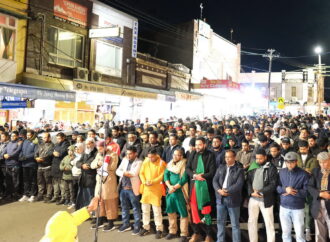

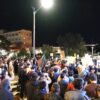











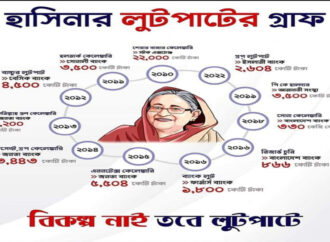






Leave a Comment
Your email address will not be published. Required fields are marked with *